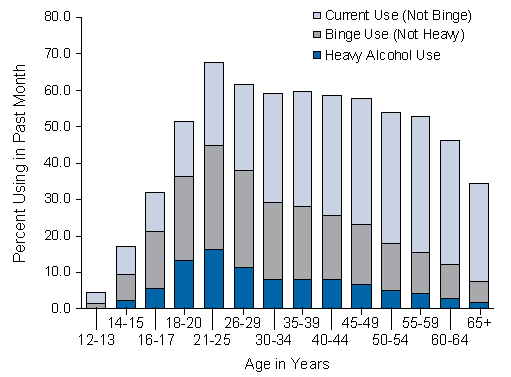Epidemiology of Alcohol Use and Deviant Drinking
Rates of "Binge" and Heavy Drinking
The most comprehensive source of epidemiological data on alcohol and drug use among adults is the National Survey on Drug Use and Health (NSDUH), an annual survey of the civilian, noninstitutionalized population of the United States aged 12 years old or older. Prior to 2002, the survey was called the National Household Survey on Drug Abuse (NHSDA). The material on this page is taken from the initial report on the 2003 NSDUH survey, which is available at the website of the Office of Applied Statistics of the Substance Abuse and Mental Health Services Administration (click here).
NSDUH collects information from residents of households, noninstitutional group quarters (e.g., shelters, rooming houses, dormitories), and civilians living on military bases. Persons excluded from the survey include homeless persons who do not use shelters, military personnel on active duty, and residents of institutional group quarters, such as jails and hospitals. Nationally, 130,605 addresses were screened for the 2003 survey, and 67,784 completed interviews were obtained.
The NSDUH survey includes questions about the recency and frequency of consumption of alcoholic beverages, such as beer, wine, whiskey, brandy, and mixed drinks. An extensive list of examples of the kinds of beverages covered is given to respondents prior to the question administration. A "drink" is defined as a can or bottle of beer, a glass of wine or a wine cooler, a shot of liquor, or a mixed drink with liquor in it. Times when the respondent only had a sip or two from a drink are not considered as consumption. Estimates for the prevalence of alcohol use are reported primarily at three levels defined for both males and females and for all ages as follows:
- Current use - At least one drink in the past 30 days (includes binge and heavy use).
- Binge use - Five or more drinks on the same occasion at least once in the past 30 days (includes heavy use).
- Heavy use - Five or more drinks on the same occasion on at least 5 different days in the past 30 days.
About half of Americans aged 12 or older reported being current drinkers of alcohol in the 2003 survey (50.1 percent). This translates to an estimated 119 million people, similar to the 2002 estimate of 120 million current drinkers.
More than one fifth (22.6 percent) of persons aged 12 or older participated in "binge drinking" at least once in the 30 days prior to the survey in 2003. This translates to about 54 million people, comparable with the number reported in 2002.
In 2003, heavy drinking was
reported by 6.8 percent of the population aged 12 or older, or 16.1 million
people. These figures are similar to those of 2002, when 6.7 percent (15.9
million people) reported heavy drinking.
Rates of alcohol use and heavy drinking vary markedly by age. As shown
in the graph below, the prevalence of current (thirty-day) alcohol use
in 2003 increased from 2.9 percent at age 12 to about 70 percent of persons
21 or 22 years old. Among older age groups, the prevalence of alcohol
use decreased with increasing age, from 61.7 percent among 26 to 29 year
olds to 46.2 percent among 60 to 64 year olds and 34.4 percent among people
aged 65 or older. The highest prevalence of both binge and heavy drinking
in 2003 was for young adults aged 18 to 25, with the peak rate of both
measures occurring at age 21. The rate of binge drinking was 41.6 percent
for young adults aged 18 to 25 and 47.8 percent at age 21. Heavy alcohol
use was reported by 15.1 percent of persons aged 18 to 25 and by 18.7
percent of persons aged 21. Clearly, the early 20s are the "prime
time" for heavy patterns of drinking, which are increasingly being
defined as deviant.
